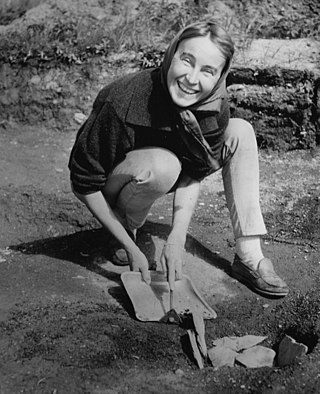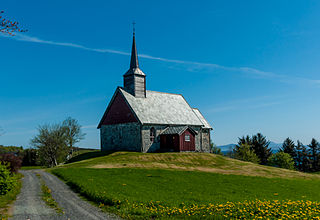
Longships were a type of specialised Scandinavian warships that have a long history in Scandinavia, with their existence being archaeologically proven and documented from at least the fourth century BC. Originally invented and used by the Norsemen for commerce, exploration, and warfare during the Viking Age, many of the longship's characteristics were adopted by other cultures, like Anglo-Saxons, and continued to influence shipbuilding for centuries.

A ship burial or boat grave is a burial in which a ship or boat is used either as the tomb for the dead and the grave goods, or as a part of the grave goods itself. If the ship is very small, it is called a boat grave. This style of burial was practiced by various seafaring cultures in Asia and Europe. Notable ship burial practices include those by the Germanic peoples, particularly by Viking Age Norsemen, as well as the pre-colonial ship burials described in the Boxer Codex in the Philippines.

Østfold is a county in Eastern Norway, which from 1 January 2020 to 31 December 2023 was part of Viken. Østfold borders Akershus and southwestern Sweden, while Buskerud and Vestfold are on the other side of Oslofjord. The county's administrative seat is Sarpsborg. The county controversially became part of the newly established Viken County on 1 January 2020. On 1 January 2024, Østfold was re-established as an independent county, however without the former municipality of Rømskog, which was amalgamated with the Akershus municipality Aurskog-Høland in 2020.

Halden, between 1665 and 1928 known as Fredrikshald, is both a town and a municipality in Østfold county, Norway. The municipality borders Sarpsborg to the northwest, Rakkestad to the north and Aremark to the east, as well as the Swedish municipalities Strömstad, Tanum and Dals-Ed respectively to the southwest, south and southeast.

Loppa is a municipality in Finnmark county, Norway. The administrative centre of the municipality is the village of Øksfjord. Other villages in Loppa include Andsnes, Bergsfjord, Langfjordhamn, Loppa, Nuvsvåg, Øksfjordbotn, Sandland, and Sør-Tverrfjord.

Smøla is a municipality in Møre og Romsdal county, Norway. It is part of the Nordmøre region. The administrative centre of the municipality is the village of Hopen, other villages include Dyrnes, Råket, and Veiholmen.

The Gokstad ship is a 9th-century Viking ship found in a burial mound at Gokstad in Sandar, Sandefjord, Vestfold, Norway. It is displayed at the Viking Ship Museum in Oslo, Norway. It is the largest preserved Viking ship in Norway.

The Oseberg ship is a well-preserved Viking ship discovered in a large burial mound at the Oseberg farm near Tønsberg in Vestfold county, Norway. This ship is commonly acknowledged to be among the finest artifacts to have survived from the Viking Age. The ship and some of its contents are displayed at the Viking Ship Museum at Bygdøy on the western side of Oslo, Norway.

Anne Stine Ingstad was a Norwegian archaeologist who, along with her husband explorer Helge Ingstad, discovered the remains of a Norse settlement at L'Anse aux Meadows in the Canadian province of Newfoundland and Labrador in 1960.

The Tune ship (Tuneskipet) is a Viking ship exhibited in the Viking Ship Museum in Bygdøy, Oslo.

Borre mound cemetery forms part of the Borre National Park at Horten in Vestfold, Norway.

Udøy is a former municipality in Møre og Romsdal county, Norway. The municipality existed from 1838 until its dissolution in 1960. It was located in the southern and central parts of the present-day Smøla Municipality. The old municipality originally encompassed all the islands surrounding the Edøyfjorden. This included the islands of Smøla, Tustna, Stabblandet, and the many smaller islands between the larger ones. The island of Edøya lies between the two and that was the center of the old municipality. Over time, parts of Edøy were split off to form other municipalities. At the time it was dissolved, Edøy municipality was 149 square kilometres (58 sq mi). The Old Edøy Church and later the (new) Edøy Church were the main churches for the municipality.

Nicolay Nicolaysen was a Norwegian archaeologist and Norway's first state employed antiquarian. He is perhaps best known for his excavations of the ship burial at Gokstad in 1880.

Møre og Romsdal is a county in the northernmost part of Western Norway. It borders the counties of Trøndelag, Innlandet, and Vestland. The county administration is located in the town of Molde, while Ålesund is the largest town. The county is governed by the Møre og Romsdal County Municipality which includes an elected county council and a county mayor. The national government is represented by the county governor.
Øysletta is a village in the municipality of Overhalla in Trøndelag county, Norway. It is located on the south shore of the river Namsen, along the now-defunct Namsos Line railway. The municipal center, Ranemsletta lies about 7.5 kilometres (4.7 mi) to the northwest and the municipal border with Grong lies about 3 kilometres (1.9 mi) east of Øysletta.

Old Edøy Church is a historic parish church of the Church of Norway in Smøla Municipality in Møre og Romsdal county, Norway. It is located on the southwestern end of the small island of Edøya, just south of the larger island of Smøla. Prior to the construction of the new Edøy Church in 1885, it was the main church for the Edøy parish which is part of the Ytre Nordmøre prosti (deanery) in the Diocese of Møre. The stone church was built in a long church style around the year 1190 by an unknown architect. The church seats about 120 people.

Edøya is an island in Smøla Municipality in Møre og Romsdal county, Norway. The 7.5-square-kilometre (2.9 sq mi) island lies in the Edøyfjorden between the larger islands of Smøla and Ertvågsøya and Tustna. The island played an important political role during the Viking Age. More recently, it was the center of the old municipality of Edøy and the historic Old Edøy Church is located on the island.
This page lists major archaeological events of 2018.

Hurum Church is a medieval stone church in Hurum, Norway. It was constructed in the 12th century. The church was damaged by fire in 1686, and rebuilt with a baroque interior. Next to the church, the Huitfeldt-family built a wooden funeral chapel in the second half of the 17th century. A new stone chapel was built in 1750, and contains the remains of the naval commander Iver Huitfeldt.

The Solsem cave is a cave lying to the southwest of the island of Leka in Leka municipality in Trøndelag, Norway. The cave is well known for its cave paintings, which were discovered in 1912. For a long time, they were the only known cave paintings in Norway.



















